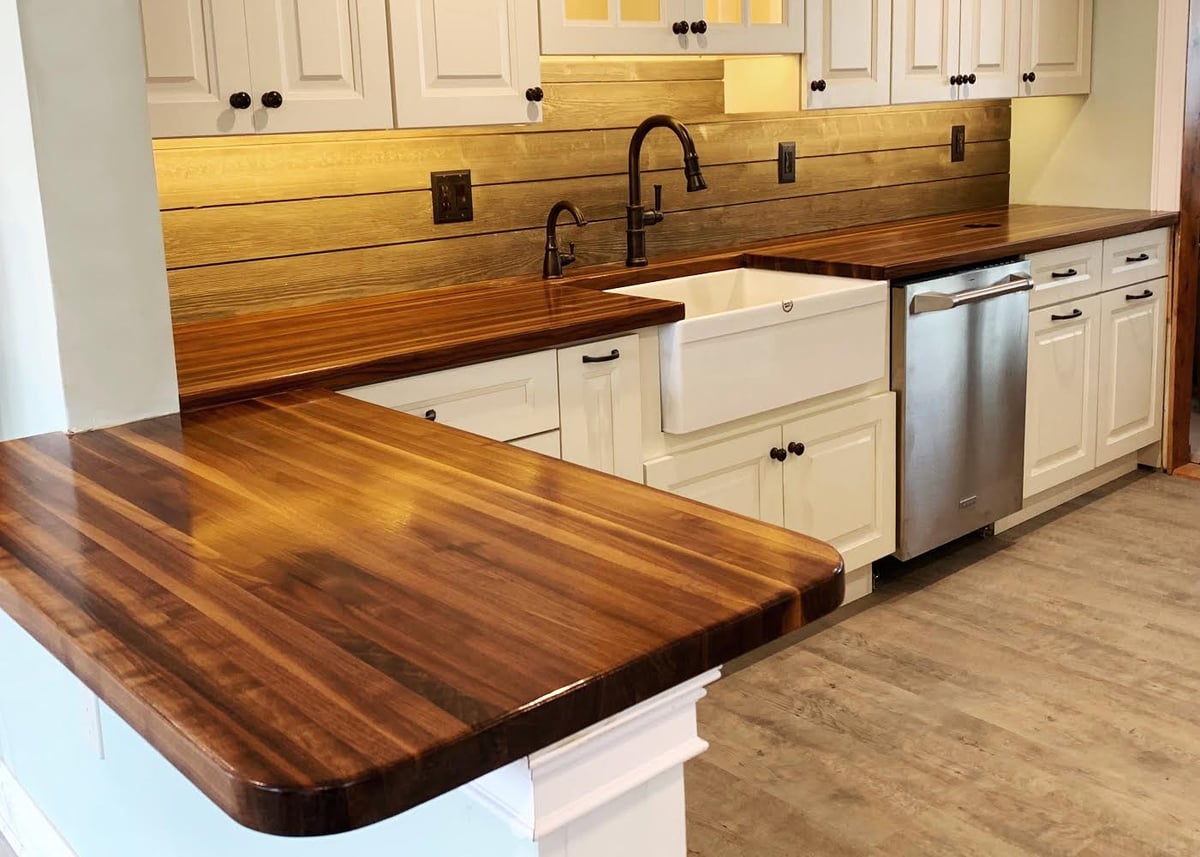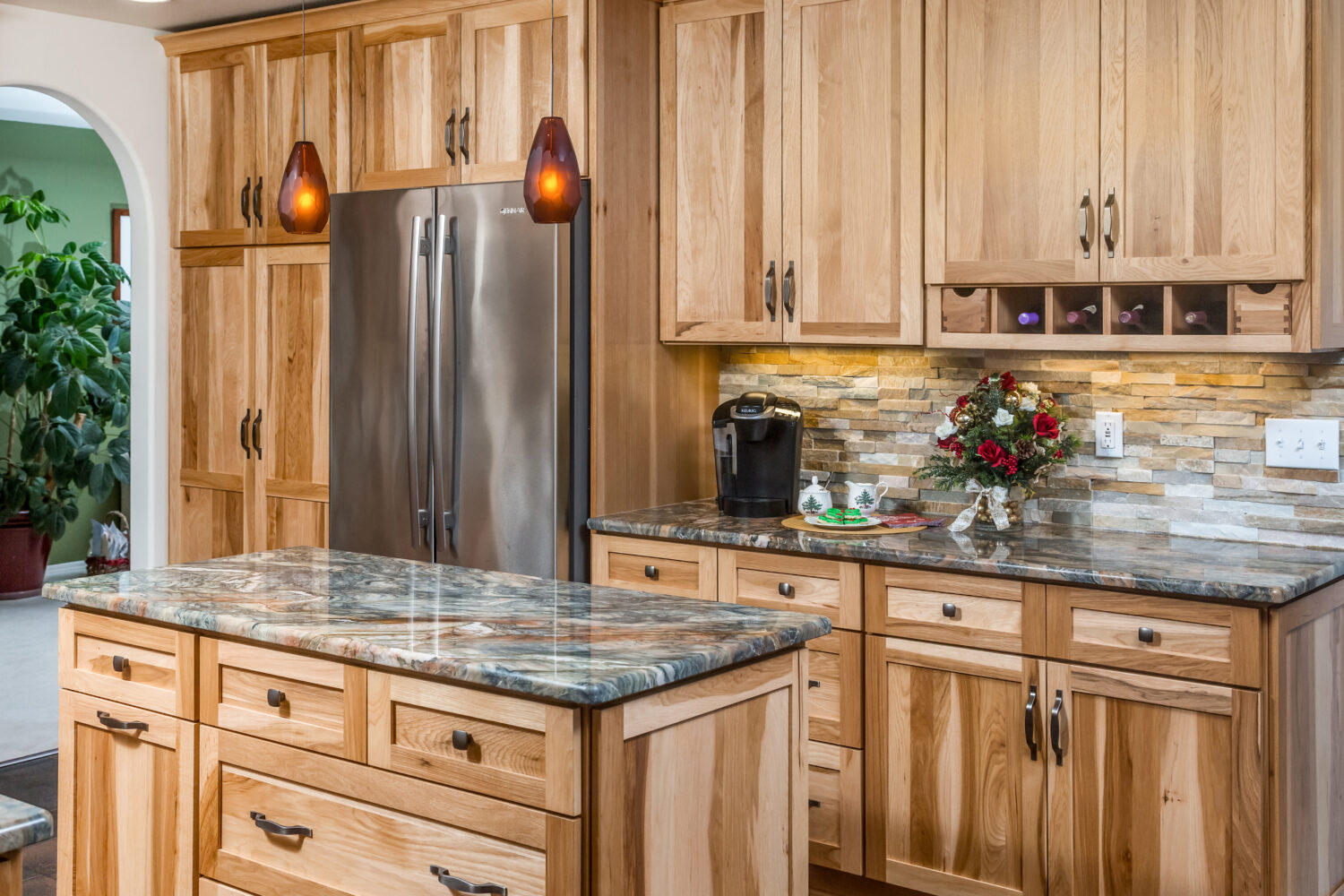Types of Wood Countertops: Cabinets With Wood Countertops

Wood countertops offer a natural, warm, and elegant touch to any kitchen. They come in a wide range of species, each with its own unique characteristics, making them a versatile option for various kitchen styles and budgets.
Popular Wood Species for Countertops
Choosing the right wood species for your countertops is crucial, as it impacts durability, aesthetics, and cost. Here are some of the most popular wood species used for countertops, along with their unique characteristics:
- Maple: Maple is known for its hardness, durability, and beautiful grain patterns. It is a good choice for high-traffic areas and can withstand scratches and dents. Maple countertops are available in a range of colors, from light blonde to reddish brown.
- Cherry: Cherry is a popular choice for countertops due to its rich, reddish-brown color and elegant grain patterns. It is a relatively hard wood, but it is more susceptible to scratches and dents than maple. Cherry countertops age gracefully, developing a warm patina over time.
- Walnut: Walnut is a luxurious wood known for its distinctive dark brown color and striking grain patterns. It is a relatively soft wood, but its beauty and durability make it a popular choice for countertops. Walnut countertops can be stained to enhance their natural color and grain patterns.
- Oak: Oak is a durable and versatile wood that is often used for countertops. It is available in a range of colors, from light blonde to dark brown. Oak countertops are known for their distinctive grain patterns and are relatively resistant to scratches and dents.
- Hardwood Plywood: Hardwood plywood is a cost-effective alternative to solid wood countertops. It is made from layers of wood veneer glued together, making it more stable and less prone to warping than solid wood. Hardwood plywood countertops are available in a variety of wood species and finishes.
Wood Countertop Finishes
The finish you choose for your wood countertops will significantly impact their durability, appearance, and maintenance requirements. Here are some common wood countertop finishes:
- Oil: Oil finishes, such as mineral oil or tung oil, penetrate the wood and provide a natural, protective layer. They are easy to apply and maintain, but they require regular reapplication. Oil finishes enhance the wood’s natural beauty and allow the grain patterns to shine through.
- Wax: Wax finishes provide a protective layer that enhances the wood’s natural shine. They are easy to apply and maintain, but they are not as durable as other finishes. Wax finishes are best suited for countertops that receive light to moderate use.
- Varnish: Varnish finishes create a hard, durable coating that protects the wood from moisture, stains, and scratches. They are available in a variety of finishes, from gloss to matte. Varnish finishes require more maintenance than oil or wax finishes, but they provide a more durable and long-lasting protection.
- Polyurethane: Polyurethane finishes are highly durable and resistant to water, stains, and scratches. They are available in a variety of finishes, from gloss to matte. Polyurethane finishes are a good choice for high-traffic areas and countertops that receive heavy use.
Selecting the Right Wood Countertop
When selecting the right wood countertop for your kitchen, consider your budget, style preferences, and the level of maintenance you are willing to undertake. Here are some factors to consider:
- Budget: Wood countertops can range in price from affordable to luxurious. Hardwood plywood countertops are typically the most affordable option, while solid wood countertops, especially exotic species, can be quite expensive.
- Kitchen Style: Wood countertops can complement a variety of kitchen styles, from traditional to modern. Consider the overall aesthetic of your kitchen and choose a wood species and finish that complements the existing décor.
- Maintenance: The level of maintenance required for wood countertops varies depending on the finish. Oil and wax finishes require regular reapplication, while varnish and polyurethane finishes require less maintenance but may need to be reapplied periodically.
Cabinet Styles and Wood Countertops

The perfect blend of cabinet style and wood countertop can transform your kitchen into a masterpiece. Choosing the right combination enhances the overall aesthetic and creates a harmonious space that reflects your personal taste.
Cabinet Styles and Their Compatibility with Wood Countertops
Cabinet styles play a crucial role in determining the overall feel of your kitchen. Here are some popular styles and how they complement wood countertops:
- Shaker Cabinets: Known for their simple, clean lines and timeless appeal, Shaker cabinets seamlessly integrate with any wood countertop. Their understated elegance allows the wood countertop’s natural beauty to take center stage.
- Farmhouse Cabinets: With their rustic charm and often distressed finishes, Farmhouse cabinets pair beautifully with wood countertops, especially those with a rustic or reclaimed look. The combination evokes a sense of warmth and comfort, perfect for creating a cozy kitchen.
- Modern Cabinets: Modern cabinets prioritize sleek, minimalist designs with clean lines and often incorporate bold geometric shapes. They complement modern wood countertops, such as maple or walnut, with their smooth surfaces and contemporary aesthetics.
- Traditional Cabinets: Traditional cabinets feature ornate details, elaborate moldings, and often showcase a classic aesthetic. They pair well with traditional wood countertops, such as cherry or mahogany, creating a sophisticated and timeless look.
Cabinet Finishes and Their Impact on Wood Countertops
The cabinet finish can significantly influence the overall aesthetic of your kitchen. Here’s how different finishes complement wood countertops:
- Painted Cabinets: Painted cabinets provide a clean, crisp backdrop that allows the wood countertop’s natural grain and color to stand out. This approach offers a versatile canvas for creating a wide range of kitchen styles.
- Stained Cabinets: Stained cabinets create a warm, inviting atmosphere that complements the natural beauty of wood countertops. The richness of the stain enhances the wood countertop’s grain and texture, creating a cohesive and sophisticated look.
- Distressed Cabinets: Distressed cabinets add a touch of rustic charm and character to a kitchen. They pair well with wood countertops that have a reclaimed or vintage look, creating a cohesive and inviting space.
Visual Guide: Cabinet Styles and Wood Countertop Combinations
| Cabinet Style | Wood Countertop Type | Overall Design Harmony |
|---|---|---|
| Shaker | Maple | Clean, minimalist, and timeless. |
| Farmhouse | Reclaimed Oak | Rustic, cozy, and inviting. |
| Modern | Walnut | Sleek, contemporary, and sophisticated. |
| Traditional | Cherry | Elegant, timeless, and sophisticated. |
Maintenance and Care

Wood countertops, while beautiful and durable, require regular maintenance to keep them looking their best and extend their lifespan. Proper cleaning, sealing, and oiling are essential to protect the wood from damage and maintain its natural beauty.
Cleaning and Maintenance Techniques
Regular cleaning is crucial for preventing dirt, grime, and spills from damaging the wood. Here’s a simple cleaning routine:
- Wipe down the countertop with a damp cloth or sponge after each use. Use mild dish soap and warm water, avoiding harsh chemicals or abrasive cleaners.
- For tougher stains, you can use a paste of baking soda and water. Apply it to the stain, let it sit for a few minutes, then scrub gently with a non-abrasive sponge.
- Dry the countertop thoroughly with a clean cloth to prevent water damage and mildew growth.
Sealing and Oiling
Sealing and oiling create a protective barrier that prevents moisture, stains, and scratches from penetrating the wood. Here’s what you need to know:
- Sealing: This process involves applying a sealant to the countertop, which forms a protective layer on the surface. Sealants are typically made from polyurethane, epoxy, or varnish.
- Oiling: This process involves applying a penetrating oil to the countertop, which nourishes the wood and enhances its natural beauty. Common oil choices include mineral oil, tung oil, or Danish oil.
Cabinets with wood countertops – The frequency of sealing and oiling depends on the type of wood, the finish, and the amount of use. Generally, it’s recommended to seal your countertops every 1-2 years and oil them every 3-6 months.
Common Issues and Potential Problems, Cabinets with wood countertops
While wood countertops are durable, they are susceptible to certain issues:
- Scratches: Scratches are common, especially if you use sharp knives or other utensils on the countertop. To prevent scratches, use a cutting board whenever possible.
- Water Damage: Water can cause warping, cracking, and discoloration if it’s left on the countertop for extended periods. Always dry spills immediately and avoid placing hot pots or pans directly on the wood surface.
- Staining: Stains can occur from spills, food, or even prolonged contact with certain materials. Sealing the countertop regularly helps prevent stains. For existing stains, try using a mild bleach solution or a stain remover designed for wood.
Preventing and Resolving Common Countertop Issues
Here are some practical tips for preventing and resolving common countertop issues:
- Use cutting boards: Always use a cutting board when preparing food to protect the countertop from scratches and knife marks.
- Use trivets: Place hot pots and pans on trivets or heat-resistant pads to prevent heat damage to the wood.
- Clean up spills immediately: Wipe up spills as soon as they occur to prevent staining and water damage.
- Regularly seal and oil: This will help protect the countertop from scratches, stains, and moisture damage.
While wood countertops bring a warm, natural aesthetic to cabinets, they can sometimes lack the visual contrast that a lighter color scheme provides. If you’re aiming for a brighter, more modern feel, consider white cabinets paired with marble countertops – a combination that exudes elegance and sophistication.
To further elevate the look, explore various backsplash options for white cabinets and marble countertops here. However, for those who prefer the timeless charm of wood, there are countless ways to create a stunning kitchen with cabinets and countertops that complement each other beautifully.
Cabinets with wood countertops offer a timeless elegance that blends seamlessly with various kitchen styles. While the warmth and natural beauty of wood are undeniable, some homeowners seek a more contemporary and durable aesthetic. For those seeking a sleek, industrial look, stainless steel cabinets and countertops offer a striking alternative.
However, the choice ultimately depends on personal preference and the desired atmosphere for the kitchen space.